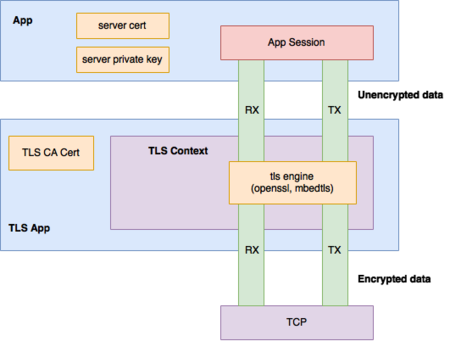Difference between revisions of "VPP/HostStack/TLS"
Florin.coras (Talk | contribs) |
Florin.coras (Talk | contribs) |
||
| Line 5: | Line 5: | ||
[[File:TLS App Architecture.png|450px|center|TLS App Architecture]] | [[File:TLS App Architecture.png|450px|center|TLS App Architecture]] | ||
| − | Because encryption and decryption operations result in the increase and decrease of number of bytes, respectively, a single client session requires four fifos. | + | Because encryption and decryption operations result in the increase and decrease of number of bytes, respectively, a single client session requires four fifos. That is, in each direction encrypted and unencrypted data is buffered in distinct fifos. |
| − | == Example Usage == | + | |
| + | |||
| + | == Example Configuration and Usage == | ||
== References == | == References == | ||
Revision as of 06:39, 7 March 2018
TLS App
TLS service is offered by the stack to other client applications via a custom builtin application. The TLS application implements a special transport type that allows it to behave as an application, from the underlying TCP transport perspective, but also as a transport, from the client application perspective. We refer to this shim layer as a TLS context. The app does not directly implement the TLS protocol, i.e., the record layer, handshaking protocols and the cryptographic computations and suites [1], instead it relies on the mbedtls library [2]. A high level view of the architecture can be seen lower:
Because encryption and decryption operations result in the increase and decrease of number of bytes, respectively, a single client session requires four fifos. That is, in each direction encrypted and unencrypted data is buffered in distinct fifos.
Example Configuration and Usage
References
[1] RFC5246 The Transport Layer Security (TLS) Protocol Version 1.2
[2] mbedtls library
